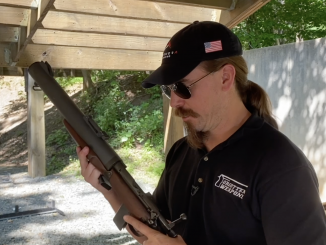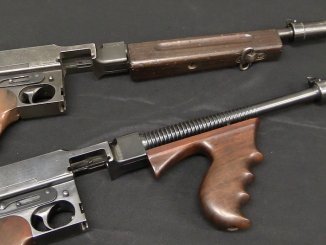One of the British lessons form the Boer War was that the distinction between infantry rifles and cavalry carbines was becoming obsolete. In 1902, they would initiate troop trials on a new short rifle pattern, intermediate in length between the old rifles and carbines, and intended to be issued universally to all troops. This would become the much-loved SMLE – Short, Magazine, Lee Enfield rifle – but first a few choices had to be made.
The 1902 trials rifles were a bit remarkable in being widely liked by the different troops that used them – only a few changes were to be made before formal adoption took place. However, there were two different patterns of the trials rifles, with different models of rear sight. The B pattern used a friction-locked range adjuster, which was found to migrate during firing (not good). The A pattern had a much more secure set of spring loaded locking notched, and would be chosen as the better of the two.
Despite a thousand of these rifles being produced for the trials, these two are the only known surviving examples. The remainder were converted in .22 caliber training guns around 1907, as their non-standard nature made them unsuitable for issue after the formal adoption of the SMLE MkI (later to be retroactively redesignated the Rifle No1 MkI.




The “A” model- You said it had a tangent rear sight. Doesn’t look like it to me. If I recall, a tangent sight compensates for the bullet’s tendency to roll with the rifling twist at long ranges. left twist would roll to the left, so the tangent imposes right windage. Right twist rolls right. Take a look at the way the sight ladder is built on a 1903 Springfield.
Springfield 1903 has a ladder-type sight. “Tangent” refers to the fact that the slide makes a tangent with the sight bed to set the range. Nothing to do with drift compensation.
What’s most interesting with the nose cap / bayonet mount is that the arrangement does indeed make fixing the bayonet have no appreciable influence on the point of impact… if you’re using Mk.VI ammunition. With Mk.VII, however, it makes the rifle shoot very high – 1.5′ at 200 yds, and as much as 4 feet at 600 yds.
Conversely, with the long rifles and Mk.VI ammunition, at 200 yds you’ve got about 2′ of drop and 6″ of lateral displacement to the right. But, with Mk.VII, there’s no appreciable effect.
I really like the coincidence that one type of ammo has a POI shift on one rifle but not the other, and vice-versa.
(Musketry Regulations 1909 Part 1, §159 and §160)
Actually it appears the rear sight protectors are place to prevent something from catching the sight ladder and opening it or damaging it when set at longer ranges. Notice the front and rear placement corresponding with the ladders.
IIRC, the cavalry saddle scabbard was being dropped around this time, in favour of cavalry carrying their rifles slung accross their backs, so that if they were somehow dismounted, they still had the rifle with them, rather than having it attached to a horse that was galloping towards the horizon.
The cavalry’s whole relevance was in question at the time, following their disastrous performance in the Sudan, so the Cavalry were keen to have a rifle which gave them equal effectiveness with Infantry.
The “Indians” who had experience on the North West Frontier, that required snap shooting and initiative on the part of individual soldiers, were also pushing for a fast handling, light short rifle. An “Indian” was also in command of the school of Musketry at Hythe.
The second South African war, seems to have crystalised the discontent that was already being felt with existing tactics, drill and long rifles, in India.
Allan Mallinson in his 2013 work “1914 Fight the Good Fight” about the British Army in the fist year of World War 1 has a section on the development of British Army small arms doctrine. He writes that the aim was volume of fire not accuracy as the army had decided to focus on war against Germany and expected the targets to be crowds of Germans. Photos of these massed formations are in Max Hastings “Catastrophe”. Hence the “mad minute”.
The truth is that no army has had very accurate rifle fire. If any had been able to achieve one hit per day per rifleman they’d have destroyed the enemy by lunch on day 2.
“He writes that the aim was volume of fire not accuracy ”
Not quite in line with the Musketry Regulations 1909 – the aim there was the fastest fire possible while still retaining acceptable accuracy – §274 states a well-trained man should be able to fire 12-15 rounds a minute without serious loss of accuracy up to 1000 yds at a distinct aiming mark. They also make it clear that they understood that individual fire beyond 600 yards was inefficient (§531), and they were very much into getting officers and NCO’s to understand beaten zones with collective rifle fire at longer ranges.
It’s well worth getting a copy if anyone wants to see the official doctrine.
Beaten zones with collective rifle fire is hardly the picture often given of the British answer to the Boer sharpshooter(another myth) is it?
I think there’s a lot of mythology in it – at least early in the campaign, dispersed Boers using cover would have had an easy time of taking on formations of British infantry in the open at extended ranges. Plus, charger loading will have given them a good rate of fire for the period, even with sticky-out-bolt Mausers.
The MR is quite interesting on the long-range point – they considered individual fire effective to no more than 600 yds, and beyond that only collective fire would have a meaningful effect. They even had techniques for manipulating beaten zones, e.g. one platoon of a company using one sight setting, another using a slightly different one (“combined sights”) so as get the most fire possible on the target area.
“Musketry Regulations 1909 – the aim there was the fastest fire possible while still retaining acceptable accuracy”
So then why next British rifle – Pattern 1913 Enfield, was designed as it was?
Now I found that Pattern 1913 was quite well optimized for rapid fire, so I should rather ask: how SMLE compares to Pattern 1913 in terms of RateOfFire.
The P13 happened because some noisy people in the hirearchy, at Bisley and so on had pushed the idea that the way the army did it was wrong and that every infantryman needed a rifle capable of extreme long-range aimed individual fire. To the point that it got as far as troop trials.
And an SMLE is a good bit faster than a P14 (having never rapid-fired a P13 I couldn’t tell you on that front 🙂 )
“The truth is that no army has had very accurate rifle fire.”
What about Switzerland? There is anecdotal story that
Shortly before World War I, the German Kaiser was the guest of the
Swiss government to observe military maneuvers. The Kaiser asked a
Swiss militiaman: ‘You are 500,000 and you shoot well, but if we
attack with 1,000,000 men what will you do?’ The soldier replied: ‘We
will shoot twice and go home.’
http://answers.google.com/answers/threadview?id=225047
Since the Swiss didn’t have a war we’ll never know what would have happened in actual combat rather than on ranges. I believe that whatever the average soldier can do with a rifle on a range should (for planning purposes) be halved for field conditions and halved again in combat.
The Leeds museum has one of the trials rifles
I looked the pattern room example up last night (in the catalogue of the collection of British Rifles)
It doesn’t claim to be a trials rifle, and it has open topped front sight protector ears.
It’s certainly an original Mk1 SMLE, but from the description it appears to be from production, rather than the trials batch.
It would be interesting for one of the people at Royal Armouries to have a look and let us know what information they have.
These rifles brought $31,000 and change each.